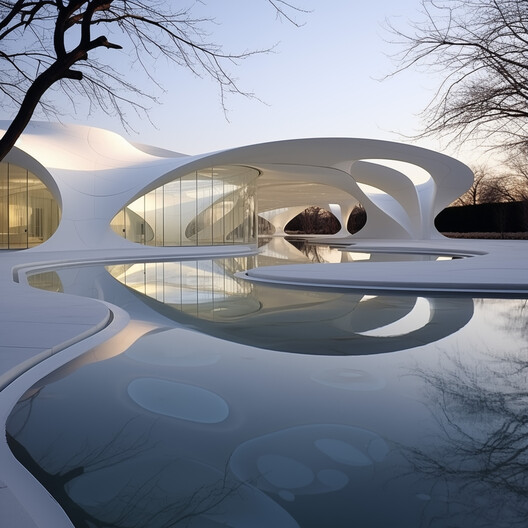How AI Technology Supports Architects and Designers
 The Museum of Temporal Delight. This visual representation was crafted in Midjourney, employing 7 language prompts and undergoing a few minor refinements. Image Credit: John Marx/ Form4 Architecture
The Museum of Temporal Delight. This visual representation was crafted in Midjourney, employing 7 language prompts and undergoing a few minor refinements. Image Credit: John Marx/ Form4 Architecture
The integration of artificial intelligence (AI) technologies has brought about significant transformations in various professional domains, including architecture and urban planning. Rather than being viewed solely as disruptive forces, AI tools are increasingly seen as valuable assets that can augment the capabilities of architects and designers. These technologies serve to streamline tasks, offer assistance in visualization, and contribute to the creative decision-making process by providing innovative solutions.
Bridging the Gap between Conceptualization and Visualization
 Cliffhouse no. 5. Image © Matias del Campo via Midjourney AI via Archipaper
Cliffhouse no. 5. Image © Matias del Campo via Midjourney AI via Archipaper
One of the primary applications of AI in architecture involves the utilization of image generation engines like DALL-E, Midjourney, and Stable Diffusion. These platforms translate textual prompts into visual representations, encouraging designers to explore ideas through language-based approaches. By facilitating rapid idea testing and reducing the complexity of design processes, these tools play a pivotal role in enhancing creative exploration within the field.
Exploring Design Possibilities with Generative Tools

Advancing beyond conventional design practices, generative AI tools leverage machine learning algorithms to generate and refine spatial plans based on predefined criteria. By enhancing existing computer-aided design (CAD) capabilities, these innovative technologies assist in space optimization, plan generation, and overall workflow enhancement.
 museum of a tundra. Image Credit: Ralph Appelbaum Associates
museum of a tundra. Image Credit: Ralph Appelbaum Associates
Platforms like Hypar offer cloud-based solutions for generative design, incorporating analysis and simulation features to optimize building proposals. Similarly, Ark AI automates schematic design processes, producing compliant feasibility studies and refined designs. Planner 5D integrates a chatbot powered by GPT-4 for real-time interior design support, utilizing AI, virtual reality (VR), and augmented reality (AR) technologies for realistic visualizations. Additionally, ARCHITEChTURES employs machine learning algorithms to facilitate AI-driven building design, enabling direct interaction with generated outcomes.
Structural Assessment for Existing Infrastructure
 Degradation on a concrete bridge. Image © roibu via Shutterstock
Degradation on a concrete bridge. Image © roibu via Shutterstock
At Drexel University, researchers are developing technologies inspired by facial recognition systems to detect and evaluate structural damage in buildings. By employing stereo-depth cameras and convolutional neural networks, these tools can identify defects such as cracks in structural elements, guiding robotic arms equipped with laser line scanners to create detailed 3D models. This approach enhances inspection efficiency, reduces manual workload, and provides precise data for maintenance decisions, benefiting restoration and adaptive reuse projects. Moreover, this technology extends to assessing the integrity of critical infrastructures like bridges, tunnels, and dams, ensuring timely diagnostics and hazard prevention.
Enhancing Urban Planning Capabilities
 Digital twin. Image © Shutterstock/ Videoflow
Digital twin. Image © Shutterstock/ Videoflow
AI systems play a pivotal role in managing vast datasets, particularly in the realm of urban planning. Urban planning tools powered by AI, such as Urban Insights and digital twins, facilitate rapid prototyping and simulation of urban environments, thereby enhancing decision-making processes. AI also contributes to climate adaptation efforts through tools like Google’s Tree Canopy, aiding in the assessment of tree coverage to mitigate heat waves effectively. Additionally, AI-driven aerial mapping tools like Colombia’s MAIIA software streamline infrastructure planning by identifying informal settlements efficiently. Furthermore, AI technologies support community engagement through VR/AR applications and intelligent traffic management systems, fostering participatory urban planning processes. Specifically, AI applications are tailored to address urban safety concerns, including initiatives focused on enhancing safety for women in urban environments.
Evolution of Architectural Workspaces
 © Fernando Guerra
© Fernando Guerra
Architects are progressively integrating AI technologies into workspace design practices. For instance, Zaha Hadid Architects’ Zaha Hadid Analytics + Insights (ZHAI) team utilizes AI to personalize work environments based on individual preferences and needs. By generating multiple interior design options swiftly and optimizing layouts using environmental and human movement data, AI tools at ZHA facilitate rapid prototyping and decision-making. However, concerns regarding privacy and data usage have emerged with the adoption of such technologies.










